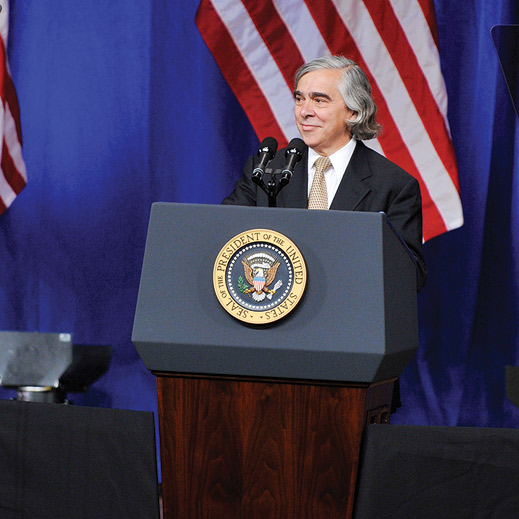Moniz Nominated as Energy Secretary
In March, President Obama nominated MIT’s Ernest J. Moniz, the Cecil and Ida Green Professor of Physics and Engineering Systems, to head the U.S. Department of Energy.

Moniz, a member of the MIT faculty since 1973, has directed the MIT Energy Initiative (MITEI) since its creation in 2006. His principal research contributions have been in theoretical nuclear physics and in energy technology and policy studies.
MIT president L. Rafael Reif said, “We have been fortunate that Professor Moniz has put his enthusiasm, deep understanding of energy, and commitment to a clean energy future to work for MIT and the Energy Initiative—and we are certain he will do the same for the American people.”
Under Moniz’s stewardship, MITEI has supported almost 800 research projects at the Institute. Twenty-three industry and public partners support its research and analysis, and it has engaged 25 percent of the MIT faculty in its projects and programs. MITEI has funded research projects in renewable energy, energy efficiency, carbon management, biotechnology, and nanotechnology.
MITEI-supported research has led to low-cost solar cells that can be printed directly onto paper or other flexible, inexpensive materials; utility-scale liquid batteries that should make it easier for power grids to integrate intermittent energy sources, such as renewables; transparent solar cells that could be built into display screens or windows; and bioengineered batteries.
Moniz served as the U.S. undersecretary of energy from 1997 to 2001. The DOE runs 17 national laboratories, has more than 16,000 federal employees, and had a budget of more than $29 billion in 2012. It is the nation’s largest funder of research in the physical sciences.
Keep Reading
Most Popular
Large language models can do jaw-dropping things. But nobody knows exactly why.
And that's a problem. Figuring it out is one of the biggest scientific puzzles of our time and a crucial step towards controlling more powerful future models.
The problem with plug-in hybrids? Their drivers.
Plug-in hybrids are often sold as a transition to EVs, but new data from Europe shows we’re still underestimating the emissions they produce.
Google DeepMind’s new generative model makes Super Mario–like games from scratch
Genie learns how to control games by watching hours and hours of video. It could help train next-gen robots too.
How scientists traced a mysterious covid case back to six toilets
When wastewater surveillance turns into a hunt for a single infected individual, the ethics get tricky.
Stay connected
Get the latest updates from
MIT Technology Review
Discover special offers, top stories, upcoming events, and more.